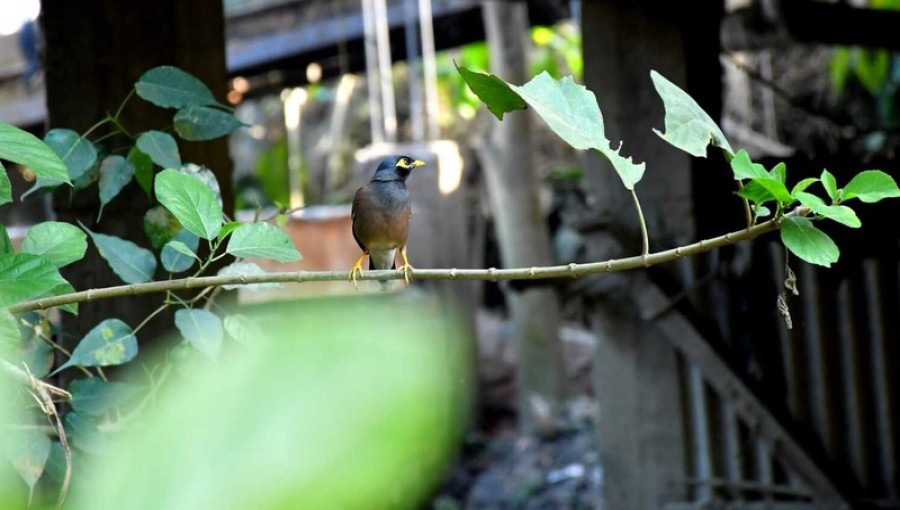Khagrachari, Jan 13, (V7N) - Waking up to the sight of a single shalik bird can cast a shadow on many people's moods. A common belief persists that encountering one shalik at the start of the day signifies bad luck, making them feel anxious about potential mishaps. Conversely, seeing a pair of shaliks in the morning brings joy to many, as it is thought to be a harbinger of good fortune. This deep-rooted belief raises the question: Is this merely superstition, or is there a logical explanation behind it?
The shalik, known as the common myna, is one of the most familiar birds in India. Found in both urban and rural areas, shaliks are equally widespread in Bangladesh and across many parts of the world. Despite its ubiquity, various superstitions about the shalik persist among people. For instance, seeing a pair of shaliks is considered an omen of a positive event. However, it is important to note that “pair” refers specifically to a male and female shalik together. This pairing is deemed auspicious, though no scientific evidence supports this claim. Such beliefs, like other superstitions, have become deeply ingrained over time.
.jpg)
Interestingly, astrological texts rarely make specific references to shalik birds. Still, many people associate seeing a single shalik with a bad day. If someone spots one shalik while heading out for work, they might become fearful or anxious. On the other hand, seeing two shaliks often lifts their spirits.
Historical and Cultural Context of Shalik Beliefs
The origins of these beliefs are not entirely clear but are deeply rooted in folklore and tradition. In many South Asian cultures, birds have been considered messengers of fortune or misfortune. The shalik, with its distinct calls and sociable nature, may have gained significance over generations as a symbol of daily omens. In rural areas, people often rely on natural cues to predict the day’s events, and the behavior of birds like the shalik plays a significant role in these practices.
Additionally, the idea of auspicious pairings is prevalent in various cultural rituals and practices. Just as paired objects or entities are considered symbols of harmony and prosperity, the sight of a male and female shalik together is interpreted as a positive sign. This belief reflects broader cultural values where balance and unity are celebrated.
The Ecological Importance of Shaliks
Beyond superstitions, the shalik plays a vital role in the environment. These birds help maintain ecological balance by controlling insect populations, dispersing seeds, and cleaning up organic waste. As omnivores, they consume a variety of pests, which benefits agriculture and reduces the need for chemical pesticides. Additionally, their seed-dispersing behavior supports forest regeneration and biodiversity conservation.
The shalik’s adaptability also makes it a valuable part of urban and rural ecosystems. They thrive in diverse environments, from bustling cities to quiet countryside, contributing to the health of these habitats. Their presence is a reminder of the interconnectedness of nature and the importance of preserving biodiversity.
Shaliks are also known for their intelligence and ability to mimic human sounds, adding to their charm. They often build nests in human dwellings, creating opportunities for people to observe their behavior closely. This interaction fosters a unique bond between humans and wildlife, encouraging conservation efforts.
Scientific Perspectives on Bird Behavior
While the cultural beliefs surrounding shaliks are fascinating, scientific studies on bird behavior provide a more grounded understanding. Birds are highly sensitive to changes in their environment and often act as indicators of ecological health. The behavior of shaliks, such as their foraging patterns and vocalizations, can offer valuable insights into local environmental conditions.
.jpg)
Research on shaliks has also highlighted their role in pest control. By consuming insects and other small creatures, these birds help farmers protect crops naturally, reducing reliance on harmful chemicals. Their seed-dispersing activities further enhance forest regeneration, promoting a sustainable environment.
Moving Beyond Superstition
It is essential to approach beliefs about shaliks with a balanced perspective. While cultural traditions and superstitions add color to human life, understanding the ecological contributions of these birds highlights their true value. Instead of focusing on unproven omens, let us appreciate the shalik for its role in maintaining environmental harmony.
By embracing a scientific view of nature and respecting wildlife, we can move beyond superstitions and cultivate a deeper appreciation for the creatures that share our world. The shalik, with its charming presence and ecological benefits, deserves recognition for more than just myths. Let’s celebrate these birds for the vital roles they play in our ecosystems and their contribution to a healthier planet.
Conclusion
The shalik bird, with its blend of cultural significance and ecological importance, serves as a bridge between tradition and science. While beliefs about single or paired shaliks may continue to captivate the imagination, it is crucial to focus on the tangible benefits these birds bring to our environment. By protecting and appreciating the shalik, we not only honor our cultural heritage but also contribute to the sustainability of our ecosystems. Let us cherish this remarkable bird for all that it symbolizes and achieves.
END/BT/SMA/































Comment: